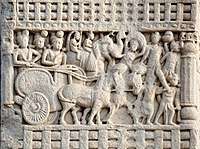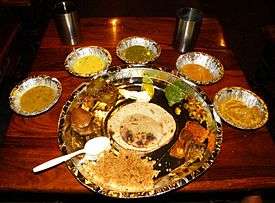Religion in India
Religion in India is characterised by a diversity of religious beliefs and practices. The preamble of Indian constitution states that the entire constitution is rooted in Hinduism as it encompasses all the different faiths, doctrines and theories that exist. However, at a later stage, the word secularism is added to the Indian constitution but with null effects of a separating state and religion in its actuality. The Indian subcontinent is the birthplace of four of the world's major religions; namely Hinduism, Buddhism, Jainism, and Sikhism. According to the 2011 census, 79.8% of the population of India practices Hinduism, 14.2% adheres to Islam, 2.3% adheres to Christianity, 1.7% adheres to Sikhism, 0.7% adheres to Buddhism and 0.4% adheres to Jainism. Zoroastrianism, Sanamahism and Judaism also have an ancient history in India, and each has several thousands of Indian adherents. India has the largest population of people adhering to Zoroastrianism (i.e. Parsis and Iranis) and Bahá'í Faith in the world,[2] even though these religions initially grew in Persia. Throughout India's history, religion has been an important part of the country's culture. Religious diversity and religious tolerance are both established in the country by the law and custom; the Constitution of India has declared the right to freedom of religion to be a fundamental right.[3]
| Part of a series on the |
| Culture of India |
|---|
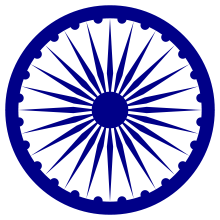 |
| History |
| People |
|
Mythology and folklore |
| Cuisine |
| Religion |
|
|
Music and performing arts |
| Sport |
|
Monuments |
|
Religion in India (2011 Census)[1]
Today, India is home to around 94% [4] of the global population of Hindus. Most Hindu shrines and temples are located in India, as are the birthplaces of most Hindu saints. Prayagraj (formerly known as Allahabad) hosts the world's largest religious pilgrimage, Prayag Kumbh Mela, where Hindus from across the world come together to bath in the confluence of three sacred rivers of India: the Ganga, the Yamuna, and the Saraswati. The Indian diaspora in the West has popularized many aspects of Hindu philosophy such as yoga, meditation, Ayurvedic medicine, divination, karma, and reincarnation.[5] The influence of Indian religions has been significant all over the world. Several Hindu-based organizations, such as the International Society for Krishna Consciousness, the Brahma Kumaris, the Ananda Marga, and others have spread Hindu spiritual beliefs and practices. The Indian subcontinent also contains the largest population of Muslims in the world, with about one-third of all Muslims being from South Asia.[6][7][8] By 2050, the Muslim population of India is projected to grow to 311 million and surpass Indonesia to become the world's largest Muslim population, although India will retain a Hindu majority (about 77%).[9][10] Being the cradle of Ahmadiyya Islam, India is one of the countries in the world with at least 2 million Ahmadi Muslims. The shrines of some of the most famous saints of Sufism, like Moinuddin Chishti and Nizamuddin Auliya, are found in India, and attract visitors from all over the world.[11] India is also home to some of the most famous monuments of Islamic architecture, such as the Taj Mahal and the Qutb Minar. Civil matters related to the community are dealt with by the Muslim Personal Law,[12] and constitutional amendments in 1985 established its primacy in family matters.[13]
History
Pre-historic religion
Evidence attesting to prehistoric religion in the Indian "subcontinent" derives from scattered Mesolithic rock paintings depicting dances and rituals. Neolithic pastoralists inhabiting the Indus Valley buried their dead in a manner suggestive of spiritual practices that incorporated notions of an afterlife.[14] Other South Asian Stone Age sites, such as the Bhimbetka rock shelters in central Madhya Pradesh and the Kupgal petroglyphs of eastern Karnataka, contain rock art portraying religious rites and evidence of possible ritualised music.[15]
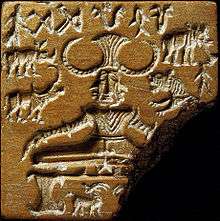
Indus Valley Civilization
The Harappan people of the Indus Valley Civilisation, which lasted from 3300 to 1400 BCE and was centered on the Indus and Ghaggar-Hakra river valleys, may have worshiped an important mother goddess symbolising fertility.[16] Excavations of Indus Valley Civilisation sites show seals with animals and "fire‑altars", indicating rituals associated with fire. A Shivlinga' of a type similar to that which is now worshiped by Hindus has also been found.[16]
Evolution of Hinduism in India
Hinduism is often regarded as the oldest religion in the world,[17] with roots tracing back to prehistoric times, over 5,000 years ago.[18] Hinduism spread through parts of Southeastern Asia, China, Korea, and Japan. Hindus worship a single god with different forms.[19]

Hinduism was practised more as the culture of the land until the British conquistador era had thrived. Hinduism as a culture had always been traditionally practised where spirituality and science are embraced in conjunction. And in Hinduism, Sanathana Dharma is considered the grandmother of all philosophies. Post western influence, Hinduism, over years has been type-casted as a religion. Hinduism's origins include the cultural elements of the Indus Valley Civilisation along with other Indian civilisations. The oldest surviving text of Hinduism is the Rigveda, produced during the Vedic period and dating to 1700–1100 BCE.[γ][20] During the Epic and Puranic periods, the earliest versions of the epic poems, in their current form including Ramayana and Mahabharata were written roughly from 500–100 BCE,[21] although these were orally transmitted through families for centuries prior to this period.[22]
After 200 BCE, several schools of thought were formally codified in the Indian philosophy, including Samkhya, Yoga, Nyaya, Vaisheshika, Purva-Mimamsa and Vedanta.[23] Hinduism, otherwise a highly theistic religion, hosted atheistic schools and atheistic philosophies. Other Indian philosophies generally regarded as orthodox include Samkhya and Mimamsa.
Rise of Shramana Religions
The historical roots of Jainism in India are traced to the 9th-century BC with the rise of Parshvanatha and his non-violent philosophy.[24][25] Mahavira the 24th Jain Tirthankara (599–527 BCE) before that 23 Tirthankaras (started from Shri Rishavdeva) for this chaubishi, (before that infinite 24 tirthankara ) stressed five vows, including ahimsa (non-violence) and asteya (non-stealing). Gautama Buddha, who founded Buddhism, was born to the Shakya clan just before Magadha (which lasted from 546–324 BCE) rose to power. His family was native to the plains of Lumbini, in what is now southern Nepal. Indian Buddhism peaked during the reign of Ashoka the Great of the Mauryan Empire, who patronised Buddhism following his conversion and unified the Indian subcontinent in the 3rd century BCE. He sent missionaries abroad, allowing Buddhism to spread across Asia.[26] Indian Buddhism declined following the loss of royal patronage offered by the Kushan Empire and such kingdoms as Magadha and Kosala.
The decline of Buddhism in India has been attributed to a variety of factors, which include the resurgence of Hinduism in the 10th and 11th centuries under Sankaracharya, the later Turkish invasion, the Buddhist focus on renunciation as opposed to familial values and private property, Hinduism's own use and appropriation of Buddhist and Jain ideals of renunciation and ahimsa, etc. Although Buddhism virtually disappeared from mainstream India by the 11th century CE, its presence remained and manifested itself through other movements such as the Bhakti tradition, Vaishnavism and the Bauls of Bengal, who are influenced by the Sahajjyana form of Buddhism that was popular in Bengal during the Pala period.
Bhakti Movement
During the 14th–17th centuries, when North India was under Muslim rule, the Bhakti movement swept through Central and Northern India. The Bhakti movement actually started in the eighth-century in south India (present-day Tamil Nadu and Kerala), and gradually spread northwards.[27] It was initiated by a loosely associated group of teachers or saints. Dnyaneshwar, Chaitanya Mahaprabhu, Vallabhacharya, Surdas, Meera Bai, Kabir, Tulsidas, Ravidas, Namdeo, Eknath, Ramdas, Tukaram and other mystics were some of the saints in the North. They taught that people could cast aside the heavy burdens of ritual and caste and the subtle complexities of philosophy, and simply express their overwhelming love for God. This period was also characterized by an abundance of devotional literature in vernacular prose and poetry in the ethnic languages of the various Indian states or provinces. The Bhakti movement gave rise to several different movements throughout India
During the Bhakti movement, many Hindu groups regarded as outside the traditional Hindu caste system followed Bhakti traditions by worshipping/following saints belonging to their respective communities. For example, Guru Ravidas was a Chamar of Uttar Pradesh; Guru Parsuram Ramnami was a Chura of Chhattisgarh, and Maharishi Ram Naval was a Bhangi of Rajasthan. In their lifetimes, several of these saints even went to the extent of fighting conversion from foreign missionaries, encouraging only Hinduism within their communities. In Assam for example, tribals were led by Gurudev Kalicharan Bramha of the Brahmo Samaj; in Nagaland by Kacha Naga; and in Central India by Birsa Munda, Hanuman Aaron, Jatra Bhagat, and Budhu Bhagat.
Sikhism
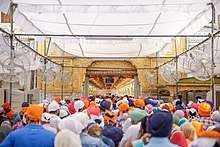
Guru Nanak Dev Ji (1469–1539) was the founder of Sikhism. The Guru Granth Sahib was first compiled by the fifth Sikh guru, Guru Arjan Dev, from the writings of the first five Sikh gurus and others saints who preached the concept of universal brotherhood, including those of the Hindu and Muslim faith. Before the death of Guru Gobind Singh, the Guru Granth Sahib was declared the eternal guru. Sikhism recognises all humans as equal before Waheguru,[28] regardless of colour, caste or lineage.[29] Sikhism strongly rejects the beliefs of fasting (vrata), superstitions, idol worship[30][31] and circumcision.[32][33] . The Sikhs believe in one eternal god and follow the teachings of the 10 gurus, the 5 K's of Sikhism, the hukums of Guru Gobind Singh, Sikh Rehat Maryada and Nitnem.It is a patit i.e kurahit for Sikhs to take any form of intoxicants which includes Drugs and Alcohol.
Introduction of Abrahamic religions
Judaism
Jews first arrived as traders from Judea in the city of Kochi, Kerala, in 562 BCE.[34] More Jews came as exiles from Israel in the year 70 CE, after the destruction of the Second Temple.[35]
Christianity
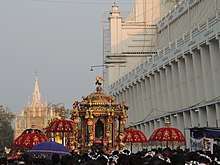
Tradition says that Christianity was introduced to India by Thomas the Apostle, who visited Muziris in Kerala in 52 CE and proselytized natives at large, who are known as Saint Thomas Christians (also known as Syrian Christians or Nasrani) today.[36][37][38][39][40] Although the exact origins of Christianity in India remain unclear, there is a general scholarly consensus that Christianity was rooted in India by the 6th century AD, including some communities who used Syriac liturgically, and it is a possibility that the religion's existence in India extends to as far back as the 1st century.[41][42][43] Christianity in India has different denominations like Roman Catholicism, Protestantism, Oriental Orthodox etc.However, the story of St Thomas coming to India in 52 CE has been contradicted by a recorded history. There was a Thomas who came, but he was a Syrian merchant, Thomas of Cana, and this happened around 500 or 600 CE. In-depth historical research on this topic can be found in the book [44] by a Canadian author and a former Christian monk Ishwar Sharan and research conducted and published by Madras Courier[45].
Most Christians reside in South India, particularly in Kerala, Tamil Nadu and Goa.[46][47] There are also large Christian populations in the North-east Indian states.[48] Christianity in India was expanded in the 16th century by Catholic Portuguese expeditions and by Protestant British and US missionaries in the 18th century.[49]
Islam
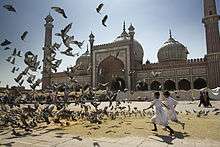
Islam is the second largest religion in India, with 14.2% of the country's population or roughly 172 million people identifying as adherents of Islam (2011 census).[50][51][52][53][54][55] It makes India the country with the largest Muslim population outside Muslim-majority countries.
Though Islam came to India in the early 7th century with the advent of Arab traders in Malabar coast, Kerala, it started to become a major religion during the Muslim rule in the Indian subcontinent. Islam's spread in India mostly took place under the Delhi Sultanate (1206–1526) and the Mughal Empire (1526–1858), greatly aided by the mystic Sufi tradition.[56]
Demographics
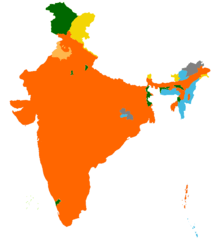
Statistics
There are six religions in India which have been awarded "National minority" status—Muslims, Christians, Sikhs, Jains, Buddhists and Zoroastrians.[57][58]
- Population trends for major religious groups in India (1951–2011)
| Religious group |
Population % 1952A |
Population % 1961 |
Population % 1971 |
Population % 1981 |
Population % 1991 |
Population % 2001 |
Population % 2011[59] |
|---|---|---|---|---|---|---|---|
| Hinduism | 84.1% | 83.45% | 82.73% | 82.30% | 81.53% | 80.46% | 79.80% |
| Islam | 9.8% | 10.69% | 11.21% | 11.75% | 12.61% | 13.43% | 14.23% |
| Christianity | 2.30% | 2.44% | 2.60% | 2.44% | 2.32% | 2.34% | 2.30% |
| Sikhism | 1.79% | 1.79% | 1.89% | 1.92% | 1.94% | 1.87% | 1.72% |
| Buddhism | 0.74% | 0.74% | 0.70% | 0.70% | 0.77% | 0.77% | 0.70% |
| Jainism | 0.46% | 0.46% | 0.48% | 0.47% | 0.40% | 0.41% | 0.37% |
| Zoroastrianism | 0.13% | 0.09% | 0.09% | 0.09% | 0.08% | 0.06% | not counted |
| Others/Religion not specified | 0.43% | 0.43% | 0.41% | 0.42% | 0.44% | 0.72% | 0.9% |
The following is a breakdown of India's religious communities:
- Characteristics of religious groups[59]
| Religious group |
Population (2011) % |
Growth (2001-2011)[60][61] |
Sex ratio (2011) (total)[62] |
Sex ratio (2011) (rural) |
Sex ratio (2011) (urban) |
Sex ratio (2011) (child)[63] |
Literacy (2011) (%)[64] |
Work participation (2011) (%)[62][65] |
|---|---|---|---|---|---|---|---|---|
| Hinduism | 79.80% | 16.8% | 939 | 946 | 921 | 913 | 73.3% | 41.0% |
| Islam | 14.23% | 24.6% | 951 | 957 | 941 | 943 | 68.5% | 32.6% |
| Christianity | 2.30% | 15.5% | 1023 | 1008 | 1046 | 958 | 84.5% | 41.9% |
| Sikhism | 1.72% | 8.4% | 903 | 905 | 898 | 828 | 75.4% | 36.3% |
| Buddhism | 0.70% | 6.1% | 965 | 960 | 973 | 933 | 81.3% | 43.1% |
| Jainism | 0.37% | 5.4% | 954 | 935 | 959 | 889 | 94.9% | 35.5% |
| Others/Religion not specified | 0.90% | n/a | 959 | 947 | 975 | 974 | n/a | n/a |
Note: When compared with 2001, India's population rose by 17.7% in 2011 with an average sex ratio of 943 and a literacy rate of 74.4%. The average work participation stood at 39.79%.
Religions
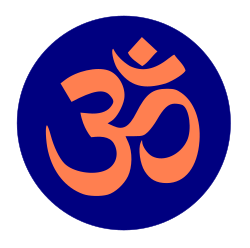
Hinduism is an ancient religion with the largest religious grouping in India, with around 966 million adherents as of 2011, composing 79.8% of the population.[59] Hinduism is diverse, with monotheism, henotheism, polytheism, panentheism, pantheism, monism, atheism, agnosticism, and gnosticism being represented[66][67][68][69]. The term Hindu, originally a geographical description, derives from the Sanskrit, Sindhu, (the historical appellation for the Indus River), and refers to a person from the land of the river Sindhu.[70]

Buddhism is an Indian, transtheistic religion and philosophy. Around 8.5 million Buddhists live in India, about 0.7% of the total population. Buddhism as a religion is practised mainly in the foothills of the Himalayas and is a significant religion in Sikkim, Arunachal Pradesh, Ladakh, Darjeeling in West Bengal and the Lahaul and Spiti districts of Himachal Pradesh. Besides, a significant number of Buddhists reside in Maharashtra. They are the Neo-Buddhists or Navayana Buddhists who, under the influence of B. R. Ambedkar embraced Buddhism in order to escape the casteist practices within Hinduism. Ambedkar is a crucial figure, along with Anagarika Dharmapala of Sri Lanka and Kripasaran Mahasthavira of Chittagong behind the revival of Buddhism in India in the 19th and 20th centuries. The escape of the 14th Dalai Lama, Tenzing Gyatso to India fleeing Chinese occupation of Tibet in 1959 and the setting up of the Tibetan Government in Exile at Dharamshala in Mcleodganj in Himachal Pradesh has also accelerated the resurgence of Buddhism in India. The effective religion in Sikkim, which joined the Indian Union in 1975 (making it India's 22nd state) remains Vajrayana Buddhism, and Padmasambhava or Guru Ugyen is a revered presence there.
Jainism is a non-theistic Indian religion and philosophical system originating in Iron Age India. Jains compose 0.4% (around 4.45 million) of India's population, and are concentrated in the states of Gujarat, Karnataka, Madhya Pradesh, Maharashtra, and Rajasthan.[71]
Sikhism began in fifteenth-century North India with the teachings of Guru Nanak and nine successive human gurus. As of 2011, there were 20.8 million Sikhs in India. Punjab is the spiritual home of Sikhs, and is the only state in India where Sikhs form a majority. There are also significant populations of Sikhs in neighboring Chandigarh, Delhi and Haryana, which were historically part of Punjab.
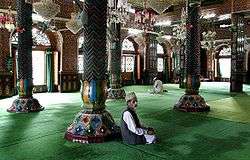
Islam is a monotheistic religion centered on the belief in one God and following the example of Muhammad; it is the largest minority religion in India. About 14.2% of the country's population or approx. 200 million people identify as adherents of Islam (2018 estimate).[72][73][74] It makes India the country with the largest Muslim population outside Muslim-majority countries. Muslims are a majority in states Jammu and Kashmir and Lakshadweep,[71] and live in high concentrations in Uttar Pradesh, Bihar, West Bengal, Assam, and Kerala.[71][75] There has been no particular census conducted in India with regards to sects, but sources suggest the largest denomination is Sunni Islam[76] with a substantial minority of Shiite Muslims and Ahmadi Muslims. Indian sources like Times of India and DNA reported the Indian Shiite population in mid-2005–2006 to be between 25% and 31% of entire Muslim population of India, which accounts them in numbers between 40 and 50 million.[77][78][76][79]
Christianity is a monotheistic religion centred on the life and teachings of Jesus as presented in the New Testament. It is the third largest religion of India, making up 2.3% of the population. St. Thomas is credited with introduction of Christianity in India. He arrived on the Malabar Coast in 52 AD.[36][39][80] Christians comprise a majority in Nagaland, Mizoram, and Meghalaya and have significant populations in Kerala and Goa.
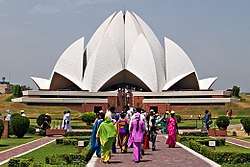
As of the census of 2001, Parsis (followers of Zoroastrianism in India) represent approximately 0.006% of the total population of India,[81] with relatively high concentrations in and around the city of Mumbai. Parsis number around 61,000 in India. There are several tribal religions in India, such as Donyi-Polo. Santhal is also one of the many tribal religions followed by the Santhal people who number around 4 million but only around 23,645 follow the religion. About 2.2 million people in India follow the Bahá'í Faith, thus forming the largest community of Bahá'ís in the world.[82] The Baha'i Faith recognises the Krishna and Buddha as manifestations of the God Almighty.[83]

Judaism is also present in India, a monotheistic religion from the Levant. There is today a very small community of Indian Jews. There were more Jews in India historically, including the Cochin Jews of Kerala, the Bene Israel of Maharashtra, and the Baghdadi Jews near Mumbai. In addition, since independence two primarily proselyte Indian Jewish communities in India: the Bnei Menashe of Mizoram and Manipur, and the Bene Ephraim, also called Telugu Jews. Of the approximately 95,000 Jews of Indian extraction, fewer than 20,000 remain in India. Some parts of India are especially popular with Israelis, swelling local Jewish populations seasonally.
Around 0.07% of the people did not state their religion in the 2001 census.
Law
The preamble to the Constitution of India proclaims India a "sovereign socialist secular democratic republic". The word secular was inserted into the Preamble by the Forty-second Amendment Act of 1976. It mandates equal treatment and tolerance of all religions. India does not have an official state religion; it enshrines the right to practice, preach, and propagate any religion. No religious instruction is imparted in government-supported schools. In S. R. Bommai vs. Union of India, the Supreme Court of India held that secularism was an integral tenet of the Constitution.[84]
Freedom of religion is a fundamental right according to the Indian Constitution. The Constitution also suggests a uniform civil code for its citizens as a Directive Principle.[85] This has not been implemented until now as Directive Principles are Constitutionally unenforceable. The Supreme Court has further held that the enactment of a uniform civil code all at once may be counter-productive to the unity of the nation, and only a gradual progressive change should be brought about (Pannalal Bansilal v State of Andhra Pradesh, 1996).[86] In Maharishi Avadesh v Union of India (1994) the Supreme Court dismissed a petition seeking a writ of mandamus against the government to introduce a common civil code, and thus laid the responsibility of its introduction on the legislature.[87]
Major religious communities not based in India continue to be governed by their own personal laws. Whilst Muslims, Christians, Zoroastrians, and Jews have personal laws exclusive to themselves; Hindus, Jains, Buddhists, and Sikhs are governed by a single personal law known as Hindu personal law. Article 25 (2)(b) of the Constitution of India states that references to Hindus include "persons professing the Sikh, Jain or Buddhist religion".[88] Furthermore, the Hindu Marriage Act ,1955 defines the legal status of Jains, Buddhists and Sikhs as legal Hindus but not "Hindus by religion".[89] Supreme Court in 2005 gave verdict that Jains, Sikhs and Buddhist are part of broader Hindu fold, as they are Indic religions and interconnected to each other, though they are distinct religions.[90]
Aspects
Religion plays a major role in the Indian way of life.[91] Rituals, worship, and other religious activities are very prominent in an individual's daily life; it is also a principal organizer of social life. The degree of religiosity varies amongst individuals; in recent decades, religious orthodoxy and observances have become less common in Indian society, particularly amongst young urban-dwellers.
Rituals
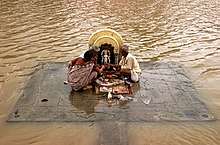
The vast majority of Indians engage in religious rituals daily.[92] Most Hindus observe religious rituals at home.[93] Observation of rituals vary greatly amongst regions, villages, and individuals. Devout Hindus perform daily chores such as worshiping puja, fire sacrifice called Yajna at the dawn after bathing (usually at a family shrine, and typically includes lighting a lamp and offering foods before the images of deities), recitation from religious scripts like Vedas, Puranas singing hymns in praise of gods etc.[93]
A notable feature in religious ritual is the division between purity and pollution. Religious acts presuppose some degree of impurity, or defilement for the practitioner, which must be overcome or neutralized, before or during ritual procedures. Purification, usually with water, is thus a typical feature of most religious action.[93] Other characteristics include a belief in the efficacy of sacrifice and concept of merit, gained through the performance of charity or good works, that will accumulate over time and reduce sufferings in the next world.[93]
Muslims offer five daily prayers at specific times of the day, indicated by adhan (call to prayer) from the local mosques. Before offering prayers, they must ritually clean themselves by performing wudu, which involves washing parts of the body that are generally exposed to dirt or dust. A recent study by the Sachar Committee found that 3–4% of Muslim children study in madrasas (Islamic schools).[94]
Diet
Dietary habits are significantly influenced by religion. India is the country with largest vegetarian population.[95] Some Indians practice lacto-vegetarianism. Vegetarianism is less common amongst Sikhs and almost uncommon amongst Muslims, Christians, Bahá'ís, Parsis, and Jews.[96] Jainism requires monks and laity, from all its sects and traditions, to be vegetarian. Furthermore, the religion also bars Jains from eating any vegetable that involves digging it from the ground. This rule, therefore, excludes potatoes, sweet potatoes, carrots, garlic, raddish etc. from Jain diet. Islam and Judaism ban pork.
Ceremonies
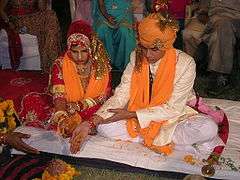
Occasions like birth, marriage, and death involve what are often elaborate sets of religious customs. In Hinduism, major life-cycle rituals include annaprashan (a baby's first intake of solid food), upanayanam ("sacred thread ceremony" undergone by upper-caste youths), and shraadh (paying homage to a deceased individual).[97][98] According to the findings of a 1995 national research paper, for most people in India, a betrothal of a young couple placing an expectation upon an exact date and time of a future wedding was a matter decided by the parents in consultation with astrologers.[97] A significant reduction in the proportion of arranged marriages has however taken place since 1995, reflecting an incremental change.
Muslims practice a series of life-cycle rituals that differ from those of Hindus, Jains, and Buddhists.[99] Several rituals mark the first days of life—including the whispering call to prayer, first bath, and shaving of the head. Religious instruction begins early. Male circumcision usually takes place after birth; in some families, it may be delayed until after the onset of puberty.[99]
Marriage requires a payment by the husband to the wife, called Meher, and the solemnization of a marital contract in a social gathering.[99] After the burial of the dead, friends and relatives gather to console the bereaved, read and recite the Quran and pray for the soul of the deceased.[99] Indian Islam is distinguished by the emphasis it places on shrines commemorating great Sufi saints.[99]
Pilgrimages
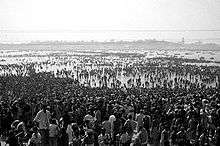 The largest religious gathering ever held on Earth, 2019 Prayag Kumbh Mela held in Allahabad (officially known as Prayagraj) attracted around 120 million people from around the world.
The largest religious gathering ever held on Earth, 2019 Prayag Kumbh Mela held in Allahabad (officially known as Prayagraj) attracted around 120 million people from around the world.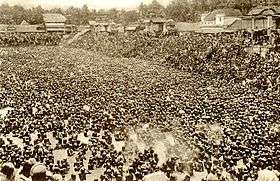 Mahamagam Festival is a holy festival celebrated once in twelve years in Tamil Nadu. Mahamagam Festival, which is held at Kumbakonam. This festival is also called as Kumbamela of South.[100][101]
Mahamagam Festival is a holy festival celebrated once in twelve years in Tamil Nadu. Mahamagam Festival, which is held at Kumbakonam. This festival is also called as Kumbamela of South.[100][101]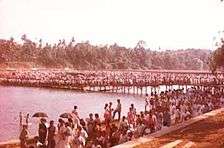 Maramon Convention, the largest annual Christian gathering in Asia, organised by the Mar Thoma Syrian Church.
Maramon Convention, the largest annual Christian gathering in Asia, organised by the Mar Thoma Syrian Church..jpg) Tawang Monastery in Arunachal Pradesh, was built in the 1600s, is the largest monastery in India and second-largest in the world after the Potala Palace in Lhasa, Tibet.
Tawang Monastery in Arunachal Pradesh, was built in the 1600s, is the largest monastery in India and second-largest in the world after the Potala Palace in Lhasa, Tibet.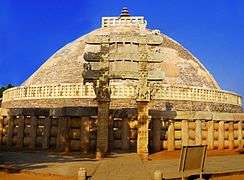 The Sanchi Stupa in Madhya Pradesh is the oldest stone structure in India. Built by Emperor Asoka in the 3rd century BCE, it houses the relics of Buddha Siddhartha Gautama.
The Sanchi Stupa in Madhya Pradesh is the oldest stone structure in India. Built by Emperor Asoka in the 3rd century BCE, it houses the relics of Buddha Siddhartha Gautama.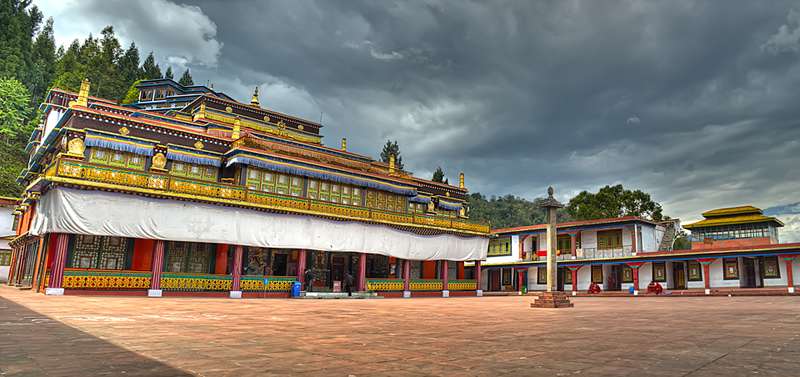 Rumtek Monastery in Sikkim is one of the major tourist attractions of Northeastern India.
Rumtek Monastery in Sikkim is one of the major tourist attractions of Northeastern India.
Many Hindu families have their own family patron deity or the kuladevata.[102] This deity is common to a lineage or a clan of several families who are connected to each other through a common ancestor.[102][103] The Khandoba of Jejuri is an example of a Kuladevata of some Maharashtrian families; he is a common Kuladevata to several castes ranging from Brahmins to Dalits.[104] The practice of worshipping local or territorial deities as Kuladevata began in the period of the Yadava dynasty.[103] Other family deities of the people of Maharashtra are Bhavani of Tuljapur, Mahalaxmi of Kolhapur, Renuka of Mahur, and Balaji of Tirupati.
India hosts numerous pilgrimage sites belonging to many religions. Hindus worldwide recognise several Indian holy cities, including Allahabad (officially known as Prayagraj), Haridwar, Varanasi, Ujjain, Rameshwaram and Vrindavan. Notable temple cities include Puri, which hosts a major Jagannath temple and Rath Yatra celebration; Tirumala - Tirupati, home to the Tirumala Venkateswara Temple; and Katra, home to the Vaishno Devi temple.
Badrinath, Puri, Dwarka and Rameswaram compose the main pilgrimage circuit of Char Dham (four abodes) hosting the four holiest Hindu temples: Badrinath Temple, Jagannath Temple, Dwarkadheesh Temple and Ramanathaswamy Temple respectively. The Himalayan towns of Badrinath, Kedarnath, Gangotri, and Yamunotri compose the smaller Chota Char Dham (mini four abodes) pilgrimage circuit. The Kumbh Mela (the "pitcher festival") is one of the holiest of Hindu pilgrimages that is held every four years; the location is rotated amongst Allahabad (Prayagraj), Haridwar, Nashik, and Ujjain. The Thalaimaippathi at Swamithope is the leading pilgrim center for the Ayyavazhis.
Amongst the Eight Great Places of Buddhism, seven are in India. Bodh Gaya, Sarnath and Kushinagar are the places where important events in the life of Gautama Buddha took place. Sanchi hosts a Buddhist stupa erected by the emperor Ashoka. Many Buddhist monasteries dot the Himalayan foothills of India, where Buddhism remains a major presence. These include the Rumtek Monastery, Enchey Monastery and Pemayangtse Monastery in Sikkim, the Tawang Monastery in Arunachal Pradesh, the Kye Monastery and Tabo Monastery in Spiti, the Ghum Monastery in Darjeeling, and Durpin Dara Monastery in Kalimpong, the Thikse Monastery in Leh, the Namgyal Monastery in Dharamshala, among many others.
For Muslims, the Dargah Shareef of Khwaza Moinuddin Chishti in Ajmer is a major pilgrimage site. Other Islamic pilgrimages include those to the Tomb of Sheikh Salim Chishti in Fatehpur Sikri, Jama Masjid in Delhi, and to Haji Ali Dargah in Mumbai. Dilwara Temples in Mount Abu, Palitana, Pavapuri, Girnar and Shravanabelagola are notable pilgrimage sites (tirtha) in Jainism.
The Harmandir Sahib in Amritsar is the most sacred gurdwara of Sikhism, while the Lotus Temple in Delhi is a prominent house of worship of the Bahá'í faith.
Relatively new pilgrimage sites include the samadhi of Meher Baba in Meherabad, which is visited by his followers from around the world [105] and the Saibaba temple in Shirdi. [106]
Minority beliefs and sects
Hinduism contains many different sub-cultures just like most other religions. The major aspects outlined above hold true for the majority of the Hindu population, but not all. Just as each state is home to an individual language, Hinduism harbors various sub-cultures whose traditions may or may not be shared by other Indians. A sect from Gujarat called the Prajapatis for example, holds water as the sacred ornament to every meal. Before and after a meal, an individual is expected to pour water in the palms of their right hand and sip the water three times.[107] This is often seen as a purification gesture: food is regarded as being holy and every individual must purify themselves before touching their food.
Other minor sects in India carry no specific name, but they are uniquely identified by the last names of each family. This convention is used more frequently in South India than in North India. For example, a relatively prominent sect in southern India prohibits making important decisions, commencing new tasks, and doing other intellectually or spiritually engaged actions after sunset. Historians believe that this tradition was derived from the concept of Rahukaalam, in which Hindus believe that a specific period of the day is inauspicious. Stringent family beliefs are thought to have led to the development of a more constrained religious hierarchy.[108] Over time, this belief was extended to discourage taking major actions and even staying awake for long periods after sunset. Examples of families which follow this tradition include Gudivada, Padalapalli, Pantham, and Kashyap.[109]
Religion and politics
Politics
Religious politics, particularly that expressed by the Hindutva movement, has strongly influenced Indian politics in the last quarter of the 20th century. Many of the elements underlying India's casteism and communalism originated during the rule of the British Raj, particularly after the late 19th century; the authorities and others often politicized religion.[110] The Indian Councils Act 1909 (widely known as the Morley-Minto Reforms Act), which established separate Hindu and Muslim electorates for the Imperial Legislature and provincial councils, was particularly divisive. It was blamed for increasing tensions between the two communities.[111]
Due to the high degree of oppression faced by the lower castes, the Constitution of India included provisions for affirmative action for certain sections of Indian society. Many states ruled by the Bharatiya Janata Party (BJP) introduced laws that made conversion more difficult; they assert that such conversions are often forced or allured.[112] The BJP, a national political party, also gained widespread media attention after its leaders associated themselves with the Ram Janmabhoomi movement and other prominent religious issues.[113]
A well-known accusation that Indian political parties make for their rivals is that they play vote bank politics, meaning give political support to issues for the sole purpose of gaining the votes of members of a particular community. Both the Congress Party and the BJP have been accused of exploiting the people by indulging in vote bank politics. The Shah Bano case, a divorce lawsuit, generated much controversy when the Congress was accused of appeasing the Muslim orthodoxy by bringing in a parliamentary amendment to negate the Supreme Court's decision. After the 2002 Gujarat violence, there were allegations of political parties indulging in vote bank politics.[114]
Caste-based politics is also important in India; caste-based discrimination and the reservation system continue to be major issues that are hotly debated.[115][116]
Education
Political parties have been accused of using their political power to manipulate educational content in a revisionist manner. Congress governments have promoted the Socialist school of history writing and economic determinism. Muslim rulers were portrayed as the agents of cultural assimilation of India into the Middle East. The BJP-led NDA government tried to promote a rather egalitarian approach of studying history instead of the rather biased socialist school of thought. The next government, formed by the UPA and led by the Congress Party, pledged to undo this and reinstate the socialist school of thought in the Indian educational system.[117] Hindu groups allege that the UPA promote Marxist and secular approaches in school curricula.[118][119]
Communalism
Communalism has played a key role in shaping the religious history of modern India. As an adverse result of the British Raj's divide and rule policy, British India was partitioned along religious lines into two states—the Muslim-majority Dominion of Pakistan (comprising what is now the Islamic Republic of Pakistan and the People's Republic of Bangladesh) and the Hindu-majority Union of India (later the Republic of India). 1947 Partition of India led to rioting amongst Hindus, Muslims, and Sikhs in Punjab, Bengal, Delhi, and other parts of India; 500,000 died as a result of the violence. The twelve million refugees that moved between the newly founded nations of India and Pakistan composed one of the largest mass migrations in modern history.[Δ][120] Since its independence, India has periodically witnessed large-scale violence sparked by underlying tensions between sections of its majority Hindu and minority Muslim communities. The Republic of India is secular; its government recognizes no official religion.
Communal conflicts
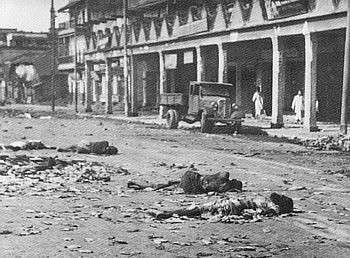
Communal conflicts have periodically plagued India since it became independent in 1947. The roots of such strife lie largely in the underlying tensions between sections of its majority Hindu and minority Muslim communities, which emerged under the Raj and during the bloody Partition of India. Such conflict also stems from the competing ideologies of Hindu nationalism versus Islamic fundamentalism; both are prevalent in parts of the Hindu and Muslim populations. This issue has plagued India since before independence. The lack of education among the masses and the ease with which corrupt politicians can take advantage of the same has been attributed as the major reason for religious conflicts in India. Even though Freedom of religion is an integral part of the India constitution, the inability to hold a communal mob's accountable has limited the exercise of religious freedom in India.
Alongside other major Indian independence leaders, Mahatma Gandhi and his Shanti sainiks ("peace soldiers") worked to quell early outbreaks of religious conflict in Bengal, including riots in Calcutta (now in West Bengal) and Noakhali District (in modern-day Bangladesh) that accompanied Muhammad Ali Jinnah's Direct Action Day, which was launched on 16 August 1946. These conflicts, waged largely with rocks and knives and accompanied by widespread looting and arson, were crude affairs. Explosives and firearms, which are rarely found in India, were far less likely to be used.[123]
Major post-independence communal conflicts include the 1984 Anti-Sikh riots, which followed Operation Blue Star by the Indian Army; heavy artillery, tanks, and helicopters were employed against the Sikh partisans inside the Harmandir Sahib, causing heavy damage to Sikhism's holiest Gurdwara. According to the Indian government estimates, the assault caused the deaths of up to 100 soldiers, 250 militants, and hundreds of civilians.[124]
This triggered Indira Gandhi's assassination by her outraged Sikh bodyguards on 31 October 1984, which set off a four-day period during which Sikhs were massacred; The Government of India reported 2,700 Sikh deaths however human rights organizations and newspapers report the death toll to be 10,000–17,000. In the aftermath of the riot, the Government of India reported 20,000 had fled the city, however the PUCL reported "at least" 50,000 displaced persons.[125]
The most affected regions were neighbourhoods in Delhi. Human rights organisations and the newspapers believe the massacre was organised.[126] The collusion of political officials in the massacres and the failure to prosecute any killers alienated normal Sikhs and increased support for the Khalistan movement. The Akal Takht, the governing religious body of Sikhism, considers the killings to be a genocide.[127]
Other incidents include the 1992 Bombay riots that followed the demolition of the Babri Mosque as a result of the Ayodhya debate, and the 2002 Gujarat violence where 790 Muslims and 254 Hindus were killed and which was preceded by the Godhra Train Burning.[128] Terrorist activities such as the 2005 Ram Janmabhoomi attack in Ayodhya, the 2006 Varanasi bombings, the 2006 Jama Masjid explosions, and the 11 July 2006 Mumbai Train Bombings are often blamed on communalism. Lesser incidents plague many towns and villages; the representative was the killing of five people in Mau, Uttar Pradesh during Hindu-Muslim rioting, which was triggered by the proposed celebration of a Hindu festival.[128]
See also
- Demographics of India
- Hinduism in India
- Irreligion in India
- Dalit Buddhist Movement
- Navayana Buddhism
- Donyi-Polo
- Hindu festivals
- Sikhism in India
- Jainism in India
- Parsis
- Ayyavazhi and Hinduism
- History of Buddhism in India
- Christianity in India
- Religion in Kerala
- Hinduism
Notes
Footnotes
- ^ α: The data exclude the Mao-Maram, Paomata, and Purul subdivisions of Manipur's Senapati district.
- ^ β: The data are "unadjusted" (without excluding Assam and Jammu and Kashmir); the 1981 census was not conducted in Assam and the 1991 census was not conducted in Jammu and Kashmir.
- ^ γ: Oberlies (1998, p. 155) gives an estimate of 1100 BCE for the youngest hymns in book ten. Estimates for a terminus post quem of the earliest hymns are far more uncertain. Oberlies (p. 158), based on "cumulative evidence", sets a wide range of 1700–1100 BCE. The EIEC (s.v. Indo-Iranian languages, p. 306) gives a range of 1500–1000 BCE. The hymns certainly post-date Indo-Iranian separation of ca. 2000 BCE. It cannot be ruled out that archaic elements of the Rigveda go back to only a few generations after this time, but philological estimates tend to date the bulk of the text to the latter half of the second millennium.
- ^ Δ: According to the most conservative estimates given by Symonds (1950, p. 74), half a million people perished and twelve million became homeless.
- ^ ε: Statistic describes resident Indian nationals up to six years in age.
Citations
- "India has 79.8% Hindus, 14.2% Muslims, says 2011 census data on religion". Firstpost. 26 August 2016. Retrieved 14 August 2016.
- Smith, Peter (2008). An introduction to the Baha'i faith. Cambridge University Press. p. 94. ISBN 978-0-521-86251-6.
- Basu, Durga Das (2013). Introduction to the Constitution of India (21 ed.). LexisNexis. p. 124. ISBN 978-81-803-8918-4.
- Samirah Majumdar, "5 Facts About Religion in India", Pew Research Center, June 29, 2018
- P. 225 Essential Hinduism By Steven Rosen
- Pechilis, Karen; Raj, SelvJanuary 2013. South Asian Religions: Tradition and Today. Routledge. ISBN 9780415448512.
- "10 Countries With the Largest Muslim Populations, 2010 and 2050". Pew Research Center's Religion & Public Life Project. 2 April 2015. Retrieved 7 February 2017.
- Diplomat, Akhilesh Pillalamarri, The. "How South Asia Will Save Global Islam". The Diplomat. Retrieved 7 February 2017.
- "5 facts about religion in India". Pew Research Center. 29 June 2018. Retrieved 15 February 2019.
- "India to have world's largest Muslim population by 2050". Khaleej Times. 5 March 2017. Retrieved 15 February 2019.
- Pg 80,81 The sacred and the feminine: imagination and sexual difference By Griselda Pollock, Victoria Turvey Sauron
- "All India Muslim Personal Law Board". Retrieved 20 July 2016.
- Pg 156, Religious Politics and the Secular States: Egypt, India, and the United States By Scott W. Hibbard – Johns Hopkins University Press, 2010
- Heehs 2002, p. 39.
- "Ancient Indians made 'rock music'". BBC News. 19 March 2004. Retrieved 7 August 2007.
- Fowler 1997, p. 90.
- P. 484 Merriam-Webster's Encyclopedia of World Religions By Wendy Doniger, M. Webster, Merriam-Webster, Inc
- P. 169 The Encyclopedia of Religion By Mircea Eliade, Charles J. Adams
- P. 22 The Complete Idiot's Guide to Geography By Joseph Gonzalez, Michael D Smith, Thomas E. Sherer
- Oberlies 1998, p. 155.
- Goldman 2007, p. 23.
- Rinehart 2004, p. 28.
- Radhakrishnan & Moore 1967, p. xviii–xxi
- Dundas 2002, p. 30.
- Zimmer 1953, p. 182-183.
- Heehs 2002, p. 106.
- Schomer & McLeod (1987), p. 1.
- Akal Ustat, Verse 85-15-1
- Akal Ustat, verse 3 to 4
- Star, Brian Leaf Rockford Register (15 August 2015). "Sikhs condemn fasting, visiting places of pilgrimage, superstitions, worship of the dead, idol worship and other blind rituals". Rockford Register Star. Retrieved 7 September 2015.
- "Petition in HC seeks ban on 'Nanak Shah Fakir'". The Tribune (India). 7 September 2015. Retrieved 2 September 2016.
- Dhillon, Dalbir Singh (28 August 2015). "Sikhism Origin and Development". Google Books. Retrieved 7 September 2015.
- Glausiusz, Josie (14 March 2004). "miscellaneous". Circumcision. Retrieved 7 September 2015.
- The Jews of India: A Story of Three Communities by Orpa Slapak. The Israel Museum, Jerusalem. 2003. p. 27. ISBN 965-278-179-7.
- Schreiber, Mordecai (2003). The Shengold Jewish Encyclopedia. Rockville, MD: Schreiber Publishing. p. 125. ISBN 1887563776.
- The Encyclopedia of Christianity, Volume 5 by Erwin Fahlbusch. Wm. B. Eerdmans Publishing - 2008. p. 285. ISBN 978-0-8028-2417-2.
- "CATHOLIC ENCYCLOPEDIA: St. Thomas Christians". www.newadvent.org.
- Neill, Stephen (2002). A History of Christianity in India: 1707-1858. Cambridge University Press. p. 237. ISBN 978-0-521-89332-9.
- The Jews of India: A Story of Three Communities by Orpa Slapak. The Israel Museum, Jerusalem. 2003. p. 27. ISBN 965-278-179-7.
- Medlycott, A E. 1905 "India and the Apostle Thomas"; Gorgias Press LLC; ISBN 1-59333-180-0.
- See Jones, Arun, "Christianity in South Asia" in Farhadian (ed.), Introducing World Christianity (Blackwell Publishing, 2012), p. 93. For a more thorough treatment of the topic which affirms Jones' claims, and for the use of Syriac, see Frykenberg, Robert Eric, Christianity in India: From Beginnings to the Present (Oxford University Press, 2008). See also the earlier Neill, Stephen, A History of Christianity in India (Cambridge University Press, 1984), pp. 48–49. Neill takes it as certain that Christianity was established in India by the 6th century and also affirms the possibility of the St. Thomas tradition being true.
- Leslie Brown, (1956) The Indian Christians of St. Thomas. An Account of the Ancient Syrian Church of Malabar, Cambridge: Cambridge University Press 1956, 1982 (repr.)
- Origin of Christianity in India – A Historiographical Critique by Dr. Benedict Vadakkekara. (2007). ISBN 81-7495-258-6.
- Ishwar Sharan (2018). The Myth of Saint Thomas and the Mylapore Shiva Temple. New Delhi: Voice of India Publications.
- "How christianity arrived in kerala through syrian immigrants". www.madrascourier.com. Retrieved 25 August 2017.
- Ross, Israel J. (1 January 1979). "Ritual and Music in South India: Syrian Christian Liturgical Music in Kerala". Asian Music. 11 (1): 80–98. doi:10.2307/833968. JSTOR 833968.
- "Christianity". India Mirror. Retrieved 13 March 2008.
- "The Story of India". www.bibleforu.com. Archived from the original on 8 March 2008. Retrieved 13 March 2008.
- "Christianity in India". M.B. Herald, Vol. 35, No. 9. Archived from the original on 9 March 2008. Retrieved 13 March 2008.
- "Hindus 79.8%, Muslims 14.2% of population: census data".
- Abantika Ghosh, Vijaita Singh (24 January 2015). "Census 2011: Muslims record decadal growth of 24.6 pc, Hindus 16.8 pc". Indian Express. Indian Express. Retrieved 27 January 2015.
- "Muslim politics:At a crossroads". livemint.com. Livemint. Retrieved 28 October 2014.
- Vijaita Singh (24 February 2015). "Over 180 million Muslims in India but they are not part of global terror groups: Govt". Indian Express. Indian Express. Retrieved 24 February 2015.
- "Muslim representation on decline". The Times of India. 31 August 2015. Retrieved 31 August 2015.
- "The Untold Census Story". OpenMagazine-PR Ramesh. 15 March 2014.
- chandru. "SUFISM IN INDIA: Its origin, history and politics". Southasiaanalysis.org. Archived from the original on 18 December 2010. Retrieved 3 February 2011.
- "National minority status for Jains". Retrieved 20 July 2016.
- "Jains become sixth minority community - Latest News & Updates at Daily News & Analysis". 21 January 2014. Retrieved 20 July 2016.
- "Population by religious community - 2011". 2011 Census of India. Office of the Registrar General & Census Commissioner. Archived from the original on 25 August 2015. Retrieved 25 August 2015. Percentages are calculated from population figures for individual religions in this word document by dividing them from total population of India.
- Aloke Tikku (26 August 2015). "Muslim population grows marginally faster: Census 2011 data". Hindustan Times. Retrieved 18 October 2016.
- "Census 2011: Hindus dip to below 80 per cent of population; Muslim share up, slows down". The Indian Express. 26 August 2015. Retrieved 20 July 2016.
- "Census 2011: Sikhs, Jains have the worst sex ratio - Latest News & Updates at Daily News & Analysis". 31 December 2015. Retrieved 20 July 2016.
- "The Times Group". Retrieved 20 July 2016.
- "Jains most literate in North, Muslims the least". 4 January 2016. Retrieved 20 July 2016.
- "Only 33% of Muslims work, lowest among all religions - Times of India". Retrieved 20 July 2016.
- Rogers, Peter (2009). Ultimate Truth, Book 1. AuthorHouse. p. 109. ISBN 978-1-4389-7968-7.CS1 maint: ref=harv (link)
- Chakravarti, Sitansu (1991). Hinduism, a way of life. Motilal Banarsidass Publ. p. 71. ISBN 978-81-208-0899-7.CS1 maint: ref=harv (link)
- "Polytheism". Encyclopædia Britannica. Encyclopædia Britannica Online. 2007. Retrieved 5 July 2007.
- Pattanaik, Devdutt (2002). The man who was a woman and other queer tales of Hindu lore. Routledge. p. 38. ISBN 978-1-56023-181-3.CS1 maint: ref=harv (link)
- "Meaning and Origin Of The Word "Hindu"". www.shraddhananda.com. Retrieved 28 October 2016.
- "Religion in India". Religion, webindia123.com. Suni Systems (P) Ltd. Retrieved 18 April 2007.
- "Muslim population growth slows". The Hindu. Retrieved 28 July 2017.
- "India has 79.8% Hindus, 14.2% Muslims, says 2011 census data on religion". Firstpost. 26 August 2015. Retrieved 28 July 2017.
- "Muslim population growth slows". The Hindu. 18 October 2016. Retrieved 18 October 2016.
- "Census of India 2001: Data on Religion". Office of the Registrar General, India. Retrieved 31 December 2007.
- International Religious Freedom Report 2003. By the United States Department of State. Retrieved on 2007-04-19.
- "Shia women too can initiate divorce". The Times of India. 6 November 2006. Retrieved 21 June 2010.
- "Talaq rights proposed for Shia women". Daily News and Analysis, www.dnaindia.com. 5 November 2006. Retrieved 21 June 2010.
- "India Third in Global Muslim Population". Twocircles.net. Retrieved 3 July 2010.
- "NSC NETWORK – Early references about the Apostolate of Saint Thomas in India, Records about the Indian tradition, Saint Thomas Christians & Statements by Indian Statesmen". Nasrani.net. Retrieved 3 February 2011.
- Bose, Ashish; et al. (4 December 2004). "Growth of the Parsi population in India". Mumbai: Government of India: National Commission for Minorities: 3. Cite journal requires
|journal=(help)CS1 maint: ref=harv (link) - "The Bahá'ís of India". bahaindia.org. National Spiritual Assembly of the Bahá'ís of India. Retrieved 18 April 2007.
- Enroth, Ronald (2005). A Guide to New Religious Movements. InterVarsity Press. p. 160. ISBN 978-0-8308-2381-9.
- Swami, Praveen (1 November 1997). "Protecting secularism and federal fair play". Frontline. 14 (22). Retrieved 17 April 2007.CS1 maint: ref=harv (link)
- Constitution of India-Part IV Article 44 Directive Principles of State Policy
- Iyer VRK (6 September 2003). "Unifying personal laws". Opinion. The Hindu. Retrieved 19 April 2007.
- Lavakare, Arvind (21 May 2002). "Where's the Uniform Civil Code?". rediff.com. Rediff.com India Limited. Retrieved 19 April 2007.
- Bakshi, P M (1996). Constitution Of India. Universal Law Publishing Co.P Ltd. p. 41. ISBN 978-81-7534-003-9. Retrieved 15 July 2010.
- Diwan, Paras (1981). Modern Hindu law: codified and uncodified. Allahabad Law Agency. Retrieved 15 July 2010.
- "Jains, Sikhs part of broader Hindu religion, says SC S.S. Negi Legal Correspondent".
- "Among Wealthy Nations ... The U.S. Stands Alone in its Embrace of Religion". The Pew Research Center for the People and the Press. 19 December 2002. Retrieved 3 June 2007.
- "Religious Life". Religions of India. Global Peace Works. Archived from the original on 1 March 2005. Retrieved 19 April 2007.
- "Domestic Worship". Country Studies. The Library of Congress. September 1995. Retrieved 19 April 2007.
- Chishti S, Jacob J (1 December 2006). "Sachar nails madrasa myth: Only 4% of Muslim kids go there". The Indian Express. Archived from the original on 29 September 2007. Retrieved 21 April 2007.
- https://www.worldatlas.com/articles/countries-with-the-highest-rates-of-vegetarianism.html
- Yadav, Yogendra; Sanjay Kumar (14 August 2006). "The food habits of a nation". hinduonnet.com. The Hindu. Archived from the original on 4 March 2011. Retrieved 21 April 2007.
- "Life-Cycle Rituals". Country Studies: India. The Library of Congress. September 1995. Retrieved 19 April 2007.
- Banerjee, Suresh Chandra (2012). "Shraddha". In Islam, Sirajul; Jamal, Ahmed A. (eds.). Banglapedia: National Encyclopedia of Bangladesh (Second ed.). Asiatic Society of Bangladesh.
- "Islamic Traditions in South Asia". Country Studies: India. The Library of Congress. September 1995. Retrieved 19 April 2007.
- "Mahamagam Festival". Retrieved 14 February 2014.
- Madan Prasad Bezbaruah; Dr. Krishna Gopal; Phal S. Girota (2003), Fairs and Festivals of India, p. 326, retrieved 14 February 2014
- Hassan 1920, pp. 110–111.
- Walunjkar, pp. 285–287.
- Government of Maharashtra 1962.
- "In His Service: A Newsletter From Meherabad" Archived 27 September 2011 at the Wayback Machine. June 2011. Myrtle Beach: Sheriar Press. p. 4.
- [S Srinivas – Journal of Contemporary Religion, 1999 – Taylor & Francis]
- R. Blake Michael – The Origins of Virasaiva Sects, 1992 – Motilal Banarsidass Pub
- "Untitled Document". Retrieved 20 July 2016.
- Makkar 1993, p. 141
- Olson & Shadle 1996, p. 759
- "Constitution doesn't permit forced conversions: Naqvi". BJP Today. 15 (9). 1–15 May 2006. Archived from the original on 21 September 2007. Retrieved 20 April 2007.CS1 maint: ref=harv (link)
- Ludden 1996, pp. 64–65
- Times News Network (25 March 2002). "Togadia wants parties to stop 'vote bank politics'". indiatimes.com. Times Internet Limited. Retrieved 20 April 2007.
- Chadha M (5 December 2006). "Despair of the discriminated Dalits". BBC News. Retrieved 3 June 2007.CS1 maint: ref=harv (link)
- Giridharadas A (22 April 2006). "Turning point in India's caste war". International Herald Tribune. Retrieved 3 June 2007.CS1 maint: ref=harv (link)
- Bureau of Democracy, Human Rights, and Labour (8 November 2005). "International Religious Freedom Report 2005". 2005 Report on International Religious Freedom. U.S. State Department. Retrieved 3 June 2007.CS1 maint: multiple names: authors list (link)
- Upadhyay R (21 August 2001). "The politics of education in India: the need for a national debate". South Asia Analysis Group. Archived from the original on 17 December 2005. Retrieved 3 June 2007.
- Upadhyay R (26 February 2000). "Opposition in India: in search of genuine issues". South Asia Analysis Group. Archived from the original on 17 December 2005. Retrieved 3 June 2007.
- Symonds 1950, p. 74.
- Sengupta, Debjani (2006). "A City Feeding on Itself: Testimonies and Histories of 'Direct Action' Day" (PDF). In Narula, Monica (ed.). Turbulence. Serai Reader. Volume 6. The Sarai Programme, Center for the Study of Developing Societies. pp. 288–295. OCLC 607413832.
- L/I/1/425. The British Library Archives, London.
- Shepard 1987, pp. 45–46.
- Nichols, B (2003). "The Politics of Assassination: Case Studies and Analysis" (PDF). Australasian Political Studies Association Conference.CS1 maint: ref=harv (link)
- Mukhoty, Gobinda; Kothari, Rajni (1984). "Who are the Guilty?". People's Union for Civil Liberties. Cite journal requires
|journal=(help)CS1 maint: ref=harv (link) - Watch/Asia, Human Rights; (U.S.), Physicians for Human Rights (May 1994). Dead silence: the legacy of human rights abuses in Punjab. Human Rights Watch. p. 10. ISBN 978-1-56432-130-5. Retrieved 29 July 2010.
- "1984 riots were 'Sikh genocide': Akal Takht – Hindustan Times". Hindustan Times. 14 July 2010. Retrieved 17 July 2010.
- Human Rights Watch 2006, p. 265.
References
- Charlton, Sue Ellen M (2004). Comparing Asian Politics: India, China, and Japan. Westview Press. ISBN 0-8133-4204-X.CS1 maint: ref=harv (link)
- Chatterjee, S; Datta, D (1984). "An Introduction to Indian Philosophy" (8th ed.). University of Calcutta. ASIN: B0007BFXK4. Cite journal requires
|journal=(help)CS1 maint: ref=harv (link) - Chopra, R.M., "A Study of Religions" (2015), Anuradha Prakashan, New Delhi, ISBN 978-93-82339-94-6
- Dundas, Paul (2002) [1992], The Jains (Second ed.), London and New York: Routledge, ISBN 0-415-26605-X
- Fowler, Jeaneane D (1997). Hinduism: Beliefs and Practices. Sussex Academic Press. ISBN 1-898723-60-5.CS1 maint: ref=harv (link)
- Goldman, RP (2007). The Ramayana of Valmiki: An Epic of Ancient India. Princeton University Press. ISBN 978-0-691-06663-9.CS1 maint: ref=harv (link)
- Heehs, P (2002). Indian Religions: A Historical Reader of Spiritual Expression and Experience. New York: New York University Press. ISBN 0-8147-3650-5.CS1 maint: ref=harv (link)
- Human Rights Watch; Press, Seven Stories (2006). Human Rights Watch World Report 2006. Seven Stories Press. ISBN 1-58322-715-6.CS1 maint: ref=harv (link)
- Ludden, David E (1996). Contesting the Nation: Religion, Community, and the Politics of Democracy in India. University of Pennsylvania Press. ISBN 0-8122-1585-0.CS1 maint: ref=harv (link)
- Makkar, SPS (1993). Law, Social Change and Communal Harmony. ABS Publications. ISBN 81-7072-047-8.CS1 maint: ref=harv (link)
- Oberlies, T (1998). "Die Religion des Rgveda". Wien. Cite journal requires
|journal=(help)CS1 maint: ref=harv (link) - Olson, James Stuart; Shadle, Robert (1996). Historical Dictionary of the British Empire. Greenwood Press. ISBN 0-313-29367-8.CS1 maint: ref=harv (link)
- Radhakrishnan, S; Moore, CA (1967). A Sourcebook in Indian Philosophy. Princeton University Press. ISBN 0-691-01958-4.CS1 maint: ref=harv (link)
- Rinehart, R (2004). Contemporary Hinduism: Ritual, Culture, and Practice. ABC-Clio. ISBN 1-57607-905-8.CS1 maint: ref=harv (link)
- Shepard, Mark (1987). Gandhi Today: A Report on Mahatma Gandhi's Successors. Shepard Publications. ISBN 0-938497-04-9.CS1 maint: ref=harv (link)
- Symonds, R (1950). "The Making of Pakistan". Faber and Faber. Cite journal requires
|journal=(help)CS1 maint: ref=harv (link) - Vadakkekara, Benedict (2007). Origin of Christianity in India: A Historiographical Critique. Delhi: Media House. ISBN 9788174952585.CS1 maint: ref=harv (link)
- Zimmer, Heinrich (1953) [April 1952], Campbell, Joseph (ed.), Philosophies Of India, London, E.C. 4: Routledge & Kegan Paul Ltd, ISBN 978-81-208-0739-6CS1 maint: location (link)
- Further reading
- Jain, Sandhya (2010). Evangelical intrusions: [Tripura, a case study]. New Delhi: Rupa & Co.
- Elst, K. (2002). Who is a Hindu?: Hindu revivalist views of Animism, Buddhism, Sikhism, and other offshoots of Hinduism.
- Goel, S.G. 2016. History of Hindu-Christian encounters, AD 304 to 1996.
- Goel, S. R. (1988). Catholic ashrams: Adopting and adapting Hindu Dharma.
- Panikkar, K. M. (1959). Asia and Western dominance. London: Allen & Unwin. ISBN 9781597406017
- Rajiv Malhotra (2011), Being Different: An Indian Challenge to Western Universalism (Publisher: HarperCollins India; ISBN 978-9-350-29190-0)
- Rajiv Malhotra (2014), Indra's Net: Defending Hinduism's Philosophical Unity (Publisher: HarperCollins India; ISBN 978-9-351-36244-9)
- Swarup, Ram (1984). Buddhism vis-a-vis Hinduism.
- Swarup, R. (1995). Hindu view of Christianity and Islam.
- Shourie, Arun (1979). Hinduism, essence, and consequence: A study of the Upanishads, the Gita, and the Brahma-Sutras. Sahibabad, Distt. Ghaziabad: Vikas. ISBN 9780706908343
- Shourie, Arun. (2006). Missionaries in India: Continuities, Changes, dilemmas. New Delhi: Rupa.ISBN 9788172232702
- Madhya Pradesh (India)., & Niyogi, M. B. (1956). Vindicated by time: The Niyogi Committee report on Christian missionary activities. Nagpur: Government Printing, Madhya Pradesh.
External links
| Wikimedia Commons has media related to Religion in India. |
- Religions in India
- "History of Religions in India". www.indohistory.com. Retrieved 1 January 2008.
- Statistics
- "Census of India 2001: Data on religion" (PDF). Government of India (Office of the Registrar General). Retrieved 28 May 2007.
- Reports
- "International Religious Freedom Report 2006: India". United States Department of State. Retrieved 28 May 2007.
